-
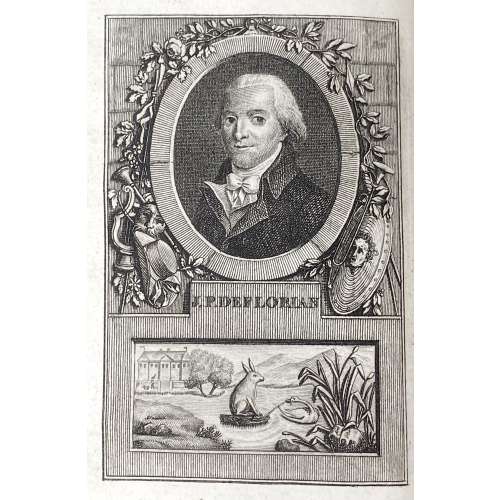 Title: FABLES | DE | M. DE FLORIAN , | de l’académie françoise, de celles de Madrid , | Florence, etc. | — | Je tâche d'y tourner le vice ridicule , | Ne pouvant l'attaquer avec des bras d'Hercule. | La Font. Fables , liv. V , I. — | [publisher's device ] | A PARIS, | DE L'IMPRIMERIE DE P. DIDOT L'AINÉ, | 1792. Pagination: ffl, [2 - h.t. / Imp.] [2 - blank / frontis.] [2 - tp. / blank] [5] 6-224 [2 - advert. / blank], bfl. Collation: numbered 1(5), 2-18(6), 19(3); engarved frontispiece portrait of Florian after François Hüet-Villiers, 5 engraved plates by Longueil, Delignon, and Gaucher after Flouest. Binding: Contemporary full mottled calf, all margins red, gilt floral ornaments to flat spine, red label with gilt lettering. Catalogue raisonné: Cohen, de Ricci 1912: p. 398-9.
Title: FABLES | DE | M. DE FLORIAN , | de l’académie françoise, de celles de Madrid , | Florence, etc. | — | Je tâche d'y tourner le vice ridicule , | Ne pouvant l'attaquer avec des bras d'Hercule. | La Font. Fables , liv. V , I. — | [publisher's device ] | A PARIS, | DE L'IMPRIMERIE DE P. DIDOT L'AINÉ, | 1792. Pagination: ffl, [2 - h.t. / Imp.] [2 - blank / frontis.] [2 - tp. / blank] [5] 6-224 [2 - advert. / blank], bfl. Collation: numbered 1(5), 2-18(6), 19(3); engarved frontispiece portrait of Florian after François Hüet-Villiers, 5 engraved plates by Longueil, Delignon, and Gaucher after Flouest. Binding: Contemporary full mottled calf, all margins red, gilt floral ornaments to flat spine, red label with gilt lettering. Catalogue raisonné: Cohen, de Ricci 1912: p. 398-9. -
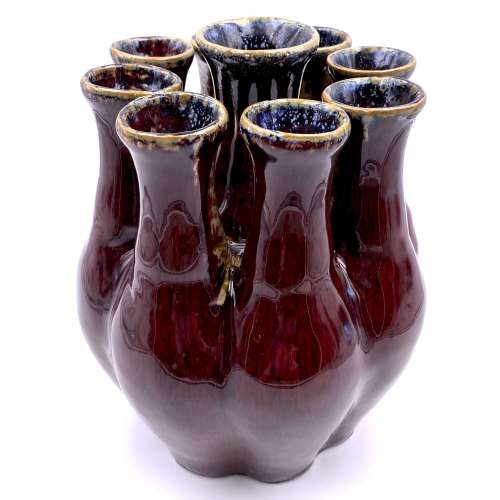 Porcelaneous stoneware vase glazed in purple-red with blue and beige splashes outside and dark blue inside, with one tube in the centre surrounded with eight peripheral tubes. Base unglazed. China, the Qianlong period (1711 – 1799) of the Qing Dynasty (1644 – 1912). Diameter: 19 cm; Height: 24 cm.
Porcelaneous stoneware vase glazed in purple-red with blue and beige splashes outside and dark blue inside, with one tube in the centre surrounded with eight peripheral tubes. Base unglazed. China, the Qianlong period (1711 – 1799) of the Qing Dynasty (1644 – 1912). Diameter: 19 cm; Height: 24 cm. -
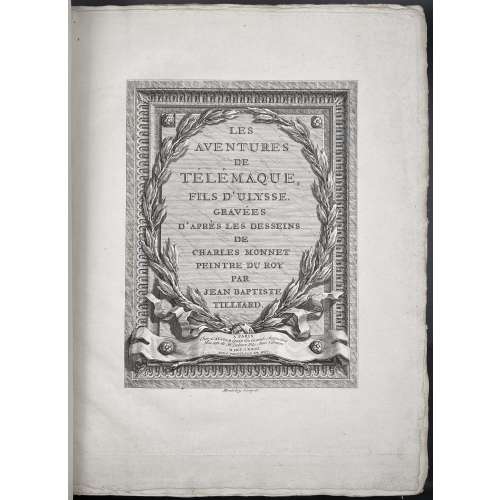 Vol. 1: Title page: LES AVENTURES | DE | TÉLÉMAQUE, | PAR FÉNELON. — | TOME PREMIER. | {publisher’s arms by Beugnet after Choffard} | DE L'IMPRIMERIE DE MONSIEUR. | M. DCC. LXXXV. || Title-frontispiece (engraved by Montulay): lettering within garland: Les Aventures de Télémaque, FILS D’ULYSSE. GRAVÉES | D’APRÈS LES DESSEINS | DE | CHARLES MONNET | PEINTRE DU ROY | PAR | JEAN BAPTISTE | TILLIARD. ||; Lettering on ribbon beneath the garland: A PARIS | Chez L’AUTEUR Quay des Grands Augustins | Maison de Mr. Debure Fils Aîné Libraire. M. DCC. LXXIII. | AVEC PRIVILEGE DU ROY. ||; Signed under the frame: Montulay Sculpsit. || Pagination: [2] – h.t. / imprint, [2] – t.p. / blank, [2] Advert., [2] d.t.p. / sommaire, [1] 2-309 [3 blanks], total 320 pages on thick wove paper plus engraved title-frontis. by Montulay, 12 engraved text leaves (one for each book), unsigned, and 36 plates (all in ornamental frame of laurel ribbon) by Tilliard after Monnet, all engravings on laid paper. Collation: 4to; vergé flyleaves at front and back, π4 A-2P4 plus 4 additional divisional titles in choirs C, F, I, and M for books 2-5, total 160 leaves, plus 49 plates. Vol. 2: Title page: Same but “TOME SECOND”. Pagination: [2] – h.t. / imprint, [2] – t.p. / blank, [1-3] 4-297 [298 blank] [2] – approb., total 304 pages plus 12 engraved text leaves (one for each book), and 36 plates, last 6 plates in a simple frame without the laurel ribbon and before signatures. Collation: 4to; π2 A-2O4 2P1 χ1, total 152 leaves, plus 48 plates. Binding: Two volumes uniformly bound in green paper boards with two red labels lettered in gilt, untrimmed. Size: overall 36.5 x 28 cm, platemark 32 x 25 cm, with white vergé flyleaves to front and back, similar pastedowns. Catalogue raisonné: Cohen, de Ricci (1912): 384-386; Ray (French): № 37, p. 74; Lewine (1898): p. 181. Contributors: François Fénelon [François de Salignac de la Mothe-Fénelon] (French, 1651 – 1715) – author. Choffard, Pierre Philippe (French, 1730 – 1809) – artist. Monnet, Charles (French, 1732 – after 1808) – artist. Montulay (French, fl. c. 1773) – engraver. Tilliard, Jean Baptiste (French, 1740 – 1813) – engraver. Beugnet, Jean (French, c. 1803) – engraver. Didot, Pierre-François (French, 1731 – 1795) – printer. Barrois, Louis-François (French, 1748 – 1835?); Barrois, Pierre-Théophile (French, 1752 – 1836); Onfroy, Eugène (French, before 1765 – 1809) ; Delalain, Louis-Alexandre (French, 1749? – 1798) – booksellers.
Vol. 1: Title page: LES AVENTURES | DE | TÉLÉMAQUE, | PAR FÉNELON. — | TOME PREMIER. | {publisher’s arms by Beugnet after Choffard} | DE L'IMPRIMERIE DE MONSIEUR. | M. DCC. LXXXV. || Title-frontispiece (engraved by Montulay): lettering within garland: Les Aventures de Télémaque, FILS D’ULYSSE. GRAVÉES | D’APRÈS LES DESSEINS | DE | CHARLES MONNET | PEINTRE DU ROY | PAR | JEAN BAPTISTE | TILLIARD. ||; Lettering on ribbon beneath the garland: A PARIS | Chez L’AUTEUR Quay des Grands Augustins | Maison de Mr. Debure Fils Aîné Libraire. M. DCC. LXXIII. | AVEC PRIVILEGE DU ROY. ||; Signed under the frame: Montulay Sculpsit. || Pagination: [2] – h.t. / imprint, [2] – t.p. / blank, [2] Advert., [2] d.t.p. / sommaire, [1] 2-309 [3 blanks], total 320 pages on thick wove paper plus engraved title-frontis. by Montulay, 12 engraved text leaves (one for each book), unsigned, and 36 plates (all in ornamental frame of laurel ribbon) by Tilliard after Monnet, all engravings on laid paper. Collation: 4to; vergé flyleaves at front and back, π4 A-2P4 plus 4 additional divisional titles in choirs C, F, I, and M for books 2-5, total 160 leaves, plus 49 plates. Vol. 2: Title page: Same but “TOME SECOND”. Pagination: [2] – h.t. / imprint, [2] – t.p. / blank, [1-3] 4-297 [298 blank] [2] – approb., total 304 pages plus 12 engraved text leaves (one for each book), and 36 plates, last 6 plates in a simple frame without the laurel ribbon and before signatures. Collation: 4to; π2 A-2O4 2P1 χ1, total 152 leaves, plus 48 plates. Binding: Two volumes uniformly bound in green paper boards with two red labels lettered in gilt, untrimmed. Size: overall 36.5 x 28 cm, platemark 32 x 25 cm, with white vergé flyleaves to front and back, similar pastedowns. Catalogue raisonné: Cohen, de Ricci (1912): 384-386; Ray (French): № 37, p. 74; Lewine (1898): p. 181. Contributors: François Fénelon [François de Salignac de la Mothe-Fénelon] (French, 1651 – 1715) – author. Choffard, Pierre Philippe (French, 1730 – 1809) – artist. Monnet, Charles (French, 1732 – after 1808) – artist. Montulay (French, fl. c. 1773) – engraver. Tilliard, Jean Baptiste (French, 1740 – 1813) – engraver. Beugnet, Jean (French, c. 1803) – engraver. Didot, Pierre-François (French, 1731 – 1795) – printer. Barrois, Louis-François (French, 1748 – 1835?); Barrois, Pierre-Théophile (French, 1752 – 1836); Onfroy, Eugène (French, before 1765 – 1809) ; Delalain, Louis-Alexandre (French, 1749? – 1798) – booksellers. -
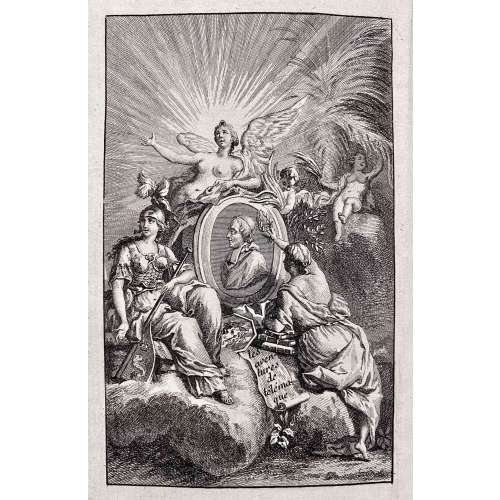 Les Aventures de Télémaque, fils d'Ulysse, Par feu Messire François de Salignac de la Mothe-Fénelon, Précepteur de Messeigneurs les Enfants de France, & depuis Archevêque - Duc de Chabray, Prince du Saint-Empire Romain, &c. / Nouvelle édition enrichie de figures en taille-douce. – À Maestricht, Chez J. E. Dufour & Ph. Roux, Imprimeurs-Libraires associés. M. DCC. LXXXII. Pagination: ffl, [i, ii - ht, explication] [2 - blank, frontis. portrait] [iii, iv - t.p., blank] [v - discours] vi-xxviii, [1] 2-484, bfl; 1 folding map and 24 plates engraved by Jean-Baptiste-Pierre Tardieu. Size: 8vo, 21 x 13 cm. Binding: full contemporary mottled calf, marbled end-papers, all margins red, raised bands, floral gilt elements in compartments, red title label, head- and tail-band absent. Point of issue: the vignette in Liv. 1 is upsidedown. Liv. 1 & 8 plates signed: Gravé par Tardieu résident à Malines. Jean Baptiste Pierre Tardieu (French, 1746 – 1816) - engraver and cartographer from a large family of artists and engravers. For English translation of this book see № LIB-2683-2021 in this collection.
Les Aventures de Télémaque, fils d'Ulysse, Par feu Messire François de Salignac de la Mothe-Fénelon, Précepteur de Messeigneurs les Enfants de France, & depuis Archevêque - Duc de Chabray, Prince du Saint-Empire Romain, &c. / Nouvelle édition enrichie de figures en taille-douce. – À Maestricht, Chez J. E. Dufour & Ph. Roux, Imprimeurs-Libraires associés. M. DCC. LXXXII. Pagination: ffl, [i, ii - ht, explication] [2 - blank, frontis. portrait] [iii, iv - t.p., blank] [v - discours] vi-xxviii, [1] 2-484, bfl; 1 folding map and 24 plates engraved by Jean-Baptiste-Pierre Tardieu. Size: 8vo, 21 x 13 cm. Binding: full contemporary mottled calf, marbled end-papers, all margins red, raised bands, floral gilt elements in compartments, red title label, head- and tail-band absent. Point of issue: the vignette in Liv. 1 is upsidedown. Liv. 1 & 8 plates signed: Gravé par Tardieu résident à Malines. Jean Baptiste Pierre Tardieu (French, 1746 – 1816) - engraver and cartographer from a large family of artists and engravers. For English translation of this book see № LIB-2683-2021 in this collection. -
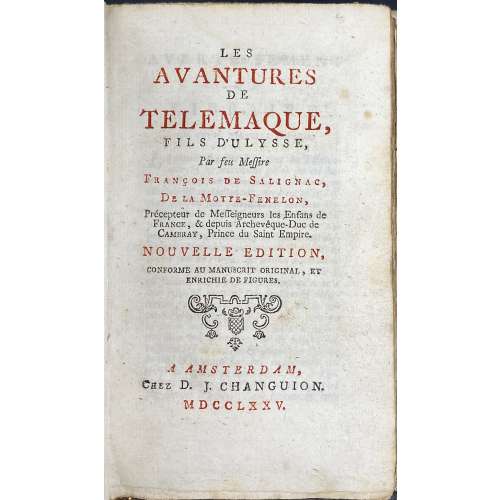 Title-page (in red and black, with tall “s”): LES | AVANTURES | DE | TELEMAQUE, | FILS D'ULYSSE, | Par seu Messire | François de Salignac, | De La Motte-Fenelon, | Precepteur de Messeigneurs les Enfans de | France, & depuis Archevêque-Duc de | Cambray, Prince du Saint Empire. | NOUVELLE EDITION, | CONFORME AU MANUSCRIT ORIGINAL, ET | ENRICHIE DE FIGURES. | {device} | A AMSTERDAM, | Chez D. J. CHANGUION. | MDCCXXV. || Pagination: fep, 1 bank leaves, frontis., [ii] title, [iii] iv-cvi, [1] 2-490 2 blank leaves, fep, total 496 pages. Collation: 12mo; 1*-4*12 5*5, A-V12 X8 (total 248 leaves) plus frontispiece and 9 plates designed and engraved by Simon Fokke (signed: “S. Fokke in et fec 1753”), and folding map (not signed). Binding: Red quarter roan over contemporary marbled vellum, only top margin trimmed. Edition: 2nd edition with these etchings after the 1st by Jan Daniel Beman in Rotterdam in 1755 (see British Museum 1887,0722.88 and 1887,0722.90 and others.) Catalogue raisonné: Not in Cohen-DeRicci, not in Lewine. Contributors: François Fénelon [François de Salignac de la Mothe-Fénelon] (French, 1651 – 1715) – author. Simon Fokke (Dutch, 1712 – 1784) – artist, engarver.
Title-page (in red and black, with tall “s”): LES | AVANTURES | DE | TELEMAQUE, | FILS D'ULYSSE, | Par seu Messire | François de Salignac, | De La Motte-Fenelon, | Precepteur de Messeigneurs les Enfans de | France, & depuis Archevêque-Duc de | Cambray, Prince du Saint Empire. | NOUVELLE EDITION, | CONFORME AU MANUSCRIT ORIGINAL, ET | ENRICHIE DE FIGURES. | {device} | A AMSTERDAM, | Chez D. J. CHANGUION. | MDCCXXV. || Pagination: fep, 1 bank leaves, frontis., [ii] title, [iii] iv-cvi, [1] 2-490 2 blank leaves, fep, total 496 pages. Collation: 12mo; 1*-4*12 5*5, A-V12 X8 (total 248 leaves) plus frontispiece and 9 plates designed and engraved by Simon Fokke (signed: “S. Fokke in et fec 1753”), and folding map (not signed). Binding: Red quarter roan over contemporary marbled vellum, only top margin trimmed. Edition: 2nd edition with these etchings after the 1st by Jan Daniel Beman in Rotterdam in 1755 (see British Museum 1887,0722.88 and 1887,0722.90 and others.) Catalogue raisonné: Not in Cohen-DeRicci, not in Lewine. Contributors: François Fénelon [François de Salignac de la Mothe-Fénelon] (French, 1651 – 1715) – author. Simon Fokke (Dutch, 1712 – 1784) – artist, engarver. -
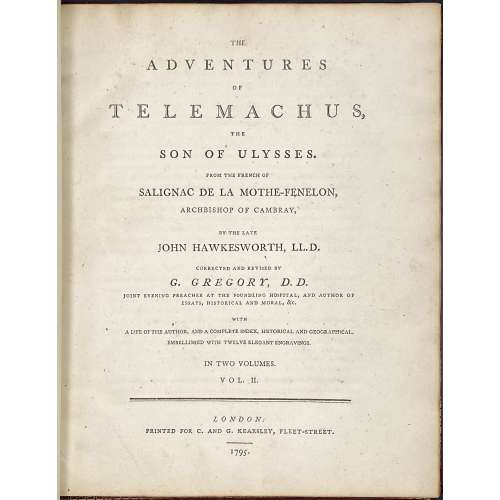 Title page: THE | ADVENTURES | OF | TELEMACHUS, | THE | SON OF ULYSSES. | FROM THE FRENCH OF | SALIGNAC DE LA MOTHE–FENELON, | ARCHBISHOP OF CAMBRAY. | BY THE LATE | JOHN HAWKESWORTH, LL. D. | CORRECTED AND REVISED BY | G. GREGORY, D. D. | JOINT EVENING PREACHER AT THE FOUNDLING HOSPITAL, AND AUTHOR OF | ESSAYS, HISTORICAL AND MORAL, &C. | WITH | A LIFE OF THE AUTHOR, AND A COMPLETE INDEX, HISTORICAL AND GEOGRAPHICAL. | EMBELLISHED WITH TWELVE ELEGANT ENGRAVINGS. | IN TWO VOLUMES. | VOL. I. [VOL. II] | — | LONDON: | PRINTED FOR C. AND G. KEARSLEY, FLEET-STREET. | 1795. || Vol. 1: collation: 2 blank leaves, π6, a-d4, B-Z4 Aa-Ff4, 2 blank leaves, 7 coloured engravings; pagination: [i-v] vi-xxxv [xxxvi], [1] 2-223 [224 blank]. Vol. 2: collation: 2 blank leaves, π4, Gg-Zz4, 3A-3K4 [a]4 b2, 2 blank leaves, 5 coloured engravings; pagination: [i-iii] iv-vii [viii], [225] 226-439, [440-452]. Exterior: 2-volume set, uniformly bound in full crimson linen morocco, key fret inside, gilt-ruled with a floral pattern between fillets to boards, flat spine decorated in gilt, with gilt lettering, marbled endpapers, AEG, 4to, 28 x 22.5 cm; printed on wove paper with watermark “WS”. Blind stamp to ffl by previous owner: "B. J. WIJNVELDT". Engravings: 12 tinted stipple engravings à la poupée: one by James Neagle (British, 1760? – 1822), four by William Bromley (British, 1769 – 1842), four by William Skelton (British, 1763 – 1848), one by John Ogborne (British, 1755 – 1837), and two by James Parker (1750 – 1805) after Thomas Stothard (British, 1755 – 1834). Ref.: Lewine (1898), p. 183: "The 1795 edition, 2 vols., 4to., with 12 engravings after Stothard, has a nominal value." Not in Cohen De Ricci, 1912. Original: François Fénelon. Les Aventures de Télémaque, fils d’Ulysse. See №№ LIB-2522-2020 and LIB-2683.2021 in this collection. John Hawkesworth (British, c. 1715 – 1773). George Gregory (British, 1754 – 1808).
Title page: THE | ADVENTURES | OF | TELEMACHUS, | THE | SON OF ULYSSES. | FROM THE FRENCH OF | SALIGNAC DE LA MOTHE–FENELON, | ARCHBISHOP OF CAMBRAY. | BY THE LATE | JOHN HAWKESWORTH, LL. D. | CORRECTED AND REVISED BY | G. GREGORY, D. D. | JOINT EVENING PREACHER AT THE FOUNDLING HOSPITAL, AND AUTHOR OF | ESSAYS, HISTORICAL AND MORAL, &C. | WITH | A LIFE OF THE AUTHOR, AND A COMPLETE INDEX, HISTORICAL AND GEOGRAPHICAL. | EMBELLISHED WITH TWELVE ELEGANT ENGRAVINGS. | IN TWO VOLUMES. | VOL. I. [VOL. II] | — | LONDON: | PRINTED FOR C. AND G. KEARSLEY, FLEET-STREET. | 1795. || Vol. 1: collation: 2 blank leaves, π6, a-d4, B-Z4 Aa-Ff4, 2 blank leaves, 7 coloured engravings; pagination: [i-v] vi-xxxv [xxxvi], [1] 2-223 [224 blank]. Vol. 2: collation: 2 blank leaves, π4, Gg-Zz4, 3A-3K4 [a]4 b2, 2 blank leaves, 5 coloured engravings; pagination: [i-iii] iv-vii [viii], [225] 226-439, [440-452]. Exterior: 2-volume set, uniformly bound in full crimson linen morocco, key fret inside, gilt-ruled with a floral pattern between fillets to boards, flat spine decorated in gilt, with gilt lettering, marbled endpapers, AEG, 4to, 28 x 22.5 cm; printed on wove paper with watermark “WS”. Blind stamp to ffl by previous owner: "B. J. WIJNVELDT". Engravings: 12 tinted stipple engravings à la poupée: one by James Neagle (British, 1760? – 1822), four by William Bromley (British, 1769 – 1842), four by William Skelton (British, 1763 – 1848), one by John Ogborne (British, 1755 – 1837), and two by James Parker (1750 – 1805) after Thomas Stothard (British, 1755 – 1834). Ref.: Lewine (1898), p. 183: "The 1795 edition, 2 vols., 4to., with 12 engravings after Stothard, has a nominal value." Not in Cohen De Ricci, 1912. Original: François Fénelon. Les Aventures de Télémaque, fils d’Ulysse. See №№ LIB-2522-2020 and LIB-2683.2021 in this collection. John Hawkesworth (British, c. 1715 – 1773). George Gregory (British, 1754 – 1808).George Kearsley the elder (British, 1739 – 1790) (Kearsley, Catharine and George – publishers)
-
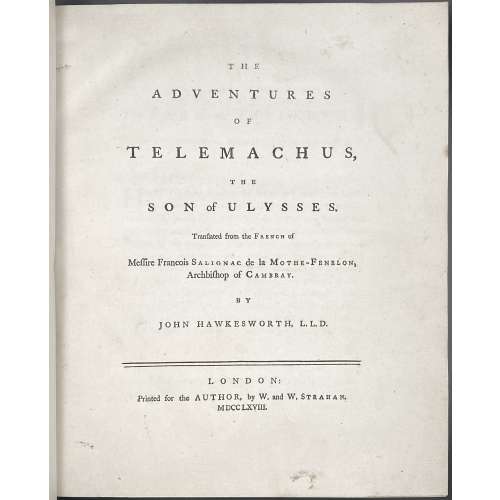 THE | ADVENTURES | OF | TELEMACHUS, | THE SON OF ULYSSES. | Translated from the French of | Messire François Salignac de la Mothe–Fenelon, | Archbishop of Cambray. | BY | JOHN HAWKESWORTH, L. L. D. | — | LONDON: | Printed for the AUTHOR, by W. and W. Strahan, | M DCC LXVIII. || Binding: half polished brown calf over marbled boards, wave ruled blind, gilt fillet ruled compartments, black label with gilt lettering to spine; 29.5 x 24.5 cm; marbled endpapers. Pagination: 2 blank leaves (wove paper), [I, ii] – t.p. / blank, [iii] iv – dedication, [v] vi-xv – subscribers, [xvi] blank, [xvii] xviii-xix – preface, [xx] xxi-xxxv – contents, [xxxvi] – errata, subscribers omitted, [1] 2-462, printed on laid paper, 2 blank leaves (wove paper). Collation: 4to; A4, a-c4 d2, B-Z4 Aa-Zz4 Aaa-Mmm4 Nnn3; 24 head- and 24 tailpieces engraved by Charles Grignion the Elder (British, 1721 – 1810) after Samuel Waly (British, 1720 – 1786). Original: François Fénelon. Les Aventures de Télémaque, fils d’Ulysse. See № LIB-2522-2020 in this collection. Not in Lewine, 1898; Not in Cohen De Ricci, 1912.
THE | ADVENTURES | OF | TELEMACHUS, | THE SON OF ULYSSES. | Translated from the French of | Messire François Salignac de la Mothe–Fenelon, | Archbishop of Cambray. | BY | JOHN HAWKESWORTH, L. L. D. | — | LONDON: | Printed for the AUTHOR, by W. and W. Strahan, | M DCC LXVIII. || Binding: half polished brown calf over marbled boards, wave ruled blind, gilt fillet ruled compartments, black label with gilt lettering to spine; 29.5 x 24.5 cm; marbled endpapers. Pagination: 2 blank leaves (wove paper), [I, ii] – t.p. / blank, [iii] iv – dedication, [v] vi-xv – subscribers, [xvi] blank, [xvii] xviii-xix – preface, [xx] xxi-xxxv – contents, [xxxvi] – errata, subscribers omitted, [1] 2-462, printed on laid paper, 2 blank leaves (wove paper). Collation: 4to; A4, a-c4 d2, B-Z4 Aa-Zz4 Aaa-Mmm4 Nnn3; 24 head- and 24 tailpieces engraved by Charles Grignion the Elder (British, 1721 – 1810) after Samuel Waly (British, 1720 – 1786). Original: François Fénelon. Les Aventures de Télémaque, fils d’Ulysse. See № LIB-2522-2020 in this collection. Not in Lewine, 1898; Not in Cohen De Ricci, 1912. -
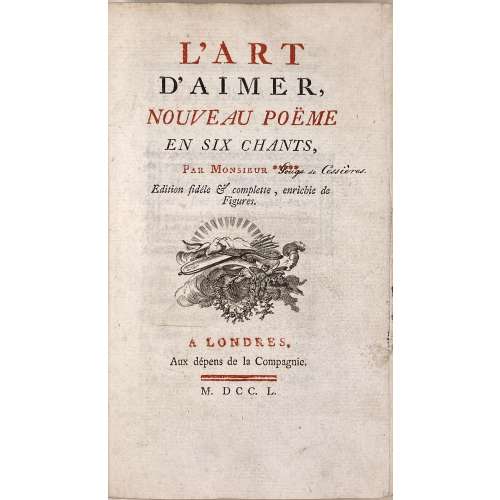 Description: 19th-century binding, 8vo,18.9 x 11.7 cm, in patterned quarter green shagreen over marbled boards, gilt elements and lettering to spine (reliure romantique), printed on laid paper, with tall "s", margins sprinkled blue. Title-page (red and black): L'ART | D'AIMER, | NOUVEAU POËME | EN SIX CHANTS, | Par Monsieur ***** Gouge de Cessières. | Edition fidéle & complette, enrichie de | Figures. | {vignette} | A LONDRES. | Aux dépens de la Compagnie. | = | M. DCC. L. || Includes: La Mort de Zulnï (pp. 175-190 ), Idée de l'Art d'aimer d'Ovide (pp. 191-244), and Lettre écrite à Monsieur *** de ******de l'Académie... (pp. 245-261). Collation: 8vo; a-b8, A-Q8 R3, lacking K2 (pp. 147/8); total 146 leaves (of 147) plus 8 engraved plates, unsigned, incl. frontispiece. Pagination: [i, ii] iii-xxxii, [1, 2] 3-261 [262 blank], lacking pp. 147/8 (K2), possibly containing Argument du chant VI; total 292 pages (of 294), ils. Catalogue raisonné: Cohen-DeRicci (under Ovid) 775, Lewine (under Ovid) 398. The artist and engravers of this edition are unknown. "Another edition, Londres (Paris), 1760, with frontispiece after Eisen by Martinet, and 6 plates after Martinet". Contributors: François-Étienne Gouge de Cessières (French, 1724 – 1782) – author. Ovid [Publius Ovidius Naso] (Roman, 43 B.C. – A.D. 17) – author. Aux dépens de la Compagnie (1685 – 1780) (Amsterdam) – publisher.
Description: 19th-century binding, 8vo,18.9 x 11.7 cm, in patterned quarter green shagreen over marbled boards, gilt elements and lettering to spine (reliure romantique), printed on laid paper, with tall "s", margins sprinkled blue. Title-page (red and black): L'ART | D'AIMER, | NOUVEAU POËME | EN SIX CHANTS, | Par Monsieur ***** Gouge de Cessières. | Edition fidéle & complette, enrichie de | Figures. | {vignette} | A LONDRES. | Aux dépens de la Compagnie. | = | M. DCC. L. || Includes: La Mort de Zulnï (pp. 175-190 ), Idée de l'Art d'aimer d'Ovide (pp. 191-244), and Lettre écrite à Monsieur *** de ******de l'Académie... (pp. 245-261). Collation: 8vo; a-b8, A-Q8 R3, lacking K2 (pp. 147/8); total 146 leaves (of 147) plus 8 engraved plates, unsigned, incl. frontispiece. Pagination: [i, ii] iii-xxxii, [1, 2] 3-261 [262 blank], lacking pp. 147/8 (K2), possibly containing Argument du chant VI; total 292 pages (of 294), ils. Catalogue raisonné: Cohen-DeRicci (under Ovid) 775, Lewine (under Ovid) 398. The artist and engravers of this edition are unknown. "Another edition, Londres (Paris), 1760, with frontispiece after Eisen by Martinet, and 6 plates after Martinet". Contributors: François-Étienne Gouge de Cessières (French, 1724 – 1782) – author. Ovid [Publius Ovidius Naso] (Roman, 43 B.C. – A.D. 17) – author. Aux dépens de la Compagnie (1685 – 1780) (Amsterdam) – publisher. -
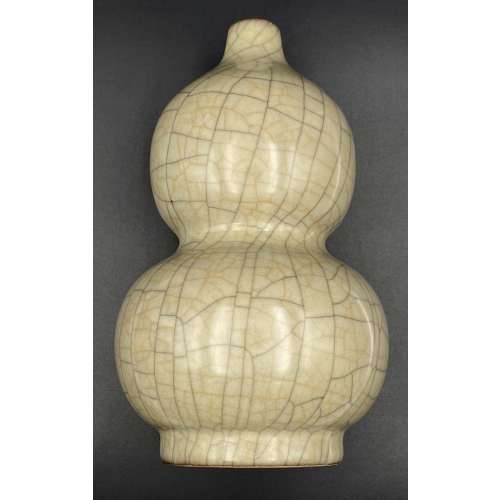 A footed double-gourd porcelain bottle with iron and gold coloured crackle on grey background. China, the Qianlong period (1711 – 1799) of the Qing Dynasty (1644 – 1912). Diameter: 12 cm; Height: 21 cm.
A footed double-gourd porcelain bottle with iron and gold coloured crackle on grey background. China, the Qianlong period (1711 – 1799) of the Qing Dynasty (1644 – 1912). Diameter: 12 cm; Height: 21 cm. -
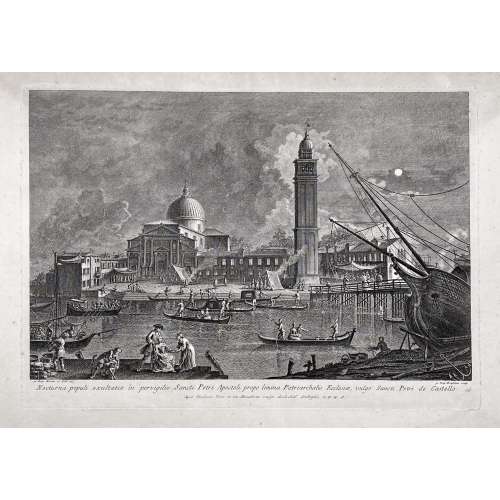
From the series of prints 'Prospectum Ædium Viarumque Insigniorum Urbis Venetiarum'. Inscribed below image left: "Jo. Bap. Moretti et Filii del. e Pinx."; right: "Jo. Baptista Brustoloni sculp."; in lower margin centre: "Nocturna populi exultatio in pervigilio Sancti Petri Apostoli prope limina Patriarchalis Ecclesiæ, vulgò Sancti Petri de Castello. / Apud Ludovicum Furlanetto supra Pontem vulgo dictum dei Baretteri C.P.E.S.". The third state, published by Teodoro Viero; the numbering on plate lower right, next to the inscription in Latin is cancelled as indicated by bibliography.
The subject is taken from a drawing by Giovanni Battista Moretti (Italian, active Venice, 1748-75) which in turn derives from a Canaletto painting. The print comes from the most important of Brustolon’s series, Prospectuum Aedium Viarumque Insignorum Urbis Venetiarum, dedicated to the Doge Marco Foscarini, from drawings by Canaletto, Moretti and sons and others, published for the first time by Ludovico Furlanetto in 1763 and later by Teodoro Viero. Giambattista Brustolon (1712–1796) was a famous Venetian engraver, a pupil of Joseph Wagner; whose talent is best displayed in his famous nocturnals: ‘riesce a dare il meglio di sé … nei famosi notturni’ (Succi).
Plate: 324 × 458 mm Sheet: 350 × 471 cm
References: The British Museum 1944,1014.209.48; The Metropolitan Museum of Art 60.611.29(4) (first state); Dario Succi, Da Carlevaris ai Tiepolo, 1983, pp.81-93, n. 55; William George Constable, J. G. Links, Canaletto: Giovanni Antonio Canal. 1697–1768. Oxford, 1989, vol. II, cat. no. 10, p. 674.
Condition: a very slight central fold, slight foxing and a very slight stain to the top, four small pinholes in corners, not affecting the engraving; else a well-margined copy in good condition.
-
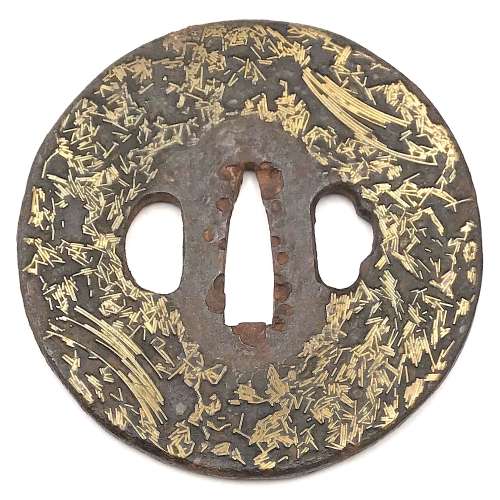 Gomoku-zōgan tsuba. Iron, inlaid with brass scrap (gomoku-zōgan), and polished. Height: 75.3 mm; Width 74.9 mm; Thickness at seppa-dai: 3.6 mm. Weight 130.2 g. Edo, 18th century. Gary D. Murtha dedicates 10 pages to this type of tsuba: "...they were made by soldering brass overlay scraps to the iron plate". Actual gomoku-zōgan tsuba are seldom found in collections most likely because they have little if any artistic attributes. In addition, many have rough surfaces making them questionable for use on a sword. It is said that many of these were produced in Yokohama for export to the West during the late Edo period". G. D. Murtha then describes the technique of making gomoku-zōgan in every detail, and states that "The brass pieces are said to represent 'fallen pine needles', a description most likely created to add aesthetic value to help market the tsuba" [see:Gary D. Murtha. Japanese sword guards. Onin - Heianjo - Yoshiro. GDM Publications, 2016; pp. 160-161].
Gomoku-zōgan tsuba. Iron, inlaid with brass scrap (gomoku-zōgan), and polished. Height: 75.3 mm; Width 74.9 mm; Thickness at seppa-dai: 3.6 mm. Weight 130.2 g. Edo, 18th century. Gary D. Murtha dedicates 10 pages to this type of tsuba: "...they were made by soldering brass overlay scraps to the iron plate". Actual gomoku-zōgan tsuba are seldom found in collections most likely because they have little if any artistic attributes. In addition, many have rough surfaces making them questionable for use on a sword. It is said that many of these were produced in Yokohama for export to the West during the late Edo period". G. D. Murtha then describes the technique of making gomoku-zōgan in every detail, and states that "The brass pieces are said to represent 'fallen pine needles', a description most likely created to add aesthetic value to help market the tsuba" [see:Gary D. Murtha. Japanese sword guards. Onin - Heianjo - Yoshiro. GDM Publications, 2016; pp. 160-161]. -
 Iron tsuba of oval form with design of cherry blossoms in positive and negative silhouette openwork (ji-sukashi and in-sukashi). Details chiseled in kebori technique. Rounded rim. Copper sekigane. Higo school, Hayashi sub-school. Unsigned. Attributed to third generation Tōhachi (1723-1791). Edo period, 18th century (Hōreki / Meiwa era: 1751-1772). Height: 78.7 mm. Width: 72.2 mm. Rim thickness: 5.2 mm. Center thickness: 5.2 mm. Provenance: Sasano Masayuki Collection, № 289: "Hayashi. Third generation Tohachi (died in in the third year of Kansei, 1791 at the age of sixty-nine). Early 18th century (Hohreki / Meiwa era). "
Iron tsuba of oval form with design of cherry blossoms in positive and negative silhouette openwork (ji-sukashi and in-sukashi). Details chiseled in kebori technique. Rounded rim. Copper sekigane. Higo school, Hayashi sub-school. Unsigned. Attributed to third generation Tōhachi (1723-1791). Edo period, 18th century (Hōreki / Meiwa era: 1751-1772). Height: 78.7 mm. Width: 72.2 mm. Rim thickness: 5.2 mm. Center thickness: 5.2 mm. Provenance: Sasano Masayuki Collection, № 289: "Hayashi. Third generation Tohachi (died in in the third year of Kansei, 1791 at the age of sixty-nine). Early 18th century (Hohreki / Meiwa era). " -
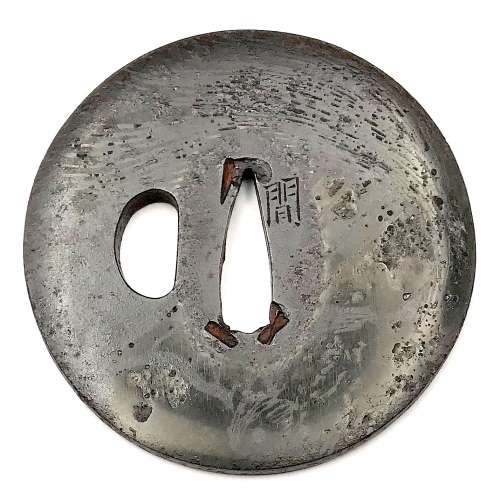 Iron tsuba of round form (width > height) decorated with a squirrel (on the face) and bamboo (on the reverse) motif in sahari flat inlay (hira-zōgan). Signed: Hazama (間) Size: 75.1mm x 75.9mm, thickness of seppa-dai 5.4mm. Early 18th century, mid Edo. Haynes/Torigoye: "There is another name for Hazama tsuba: the Kameyama school. In the period from Hōei to Kyōhō (1704-36) at Kameyama, in the province of Ise, the Kunitomo family made this style of tsuba" [...] The two artists who are best known for the sahari style of inlaid tsuba are Sadahide and Masahide" [...] The signature Hazama should be considered as that of Masahide". Sahari inlay is the distinctive characteristics of Hazama school. Sahari is an alloy of copper, tin, lead, zinc and silver. Hazama tsuba was carved patterns at first, then poured heated into the carvings on iron ground. Because it is an alloy, sahari shows different colors in each tsuba. According to Merrily Baird [Symbols, p. 163], "squirrels (risu) ... have no symbolic importance". NBTHK certificate №448388.
Iron tsuba of round form (width > height) decorated with a squirrel (on the face) and bamboo (on the reverse) motif in sahari flat inlay (hira-zōgan). Signed: Hazama (間) Size: 75.1mm x 75.9mm, thickness of seppa-dai 5.4mm. Early 18th century, mid Edo. Haynes/Torigoye: "There is another name for Hazama tsuba: the Kameyama school. In the period from Hōei to Kyōhō (1704-36) at Kameyama, in the province of Ise, the Kunitomo family made this style of tsuba" [...] The two artists who are best known for the sahari style of inlaid tsuba are Sadahide and Masahide" [...] The signature Hazama should be considered as that of Masahide". Sahari inlay is the distinctive characteristics of Hazama school. Sahari is an alloy of copper, tin, lead, zinc and silver. Hazama tsuba was carved patterns at first, then poured heated into the carvings on iron ground. Because it is an alloy, sahari shows different colors in each tsuba. According to Merrily Baird [Symbols, p. 163], "squirrels (risu) ... have no symbolic importance". NBTHK certificate №448388. -
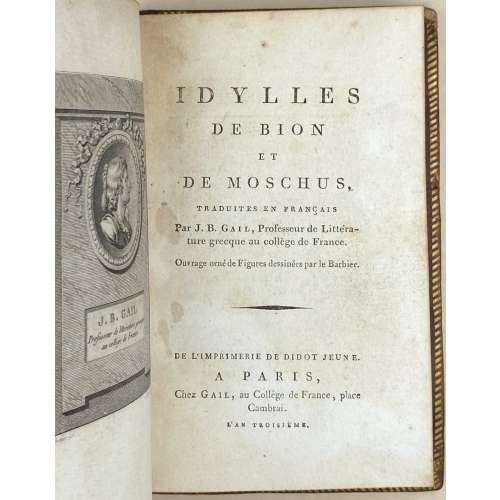 Title-page: IDYLLES | DE BION | ET | DE MOSCHUS, | TRADUITES EN FRANÇAIS | Par J. B. Gail, Professeur de littéra- | ture grecque au collège de France. | Ouvrage orné de Figures dessinées par le Barbier. | DE L’IMPRIMERIE DE DIDOT JEUNE. | A PARIS, | Chez Gail, au Collège de France, place | Cambrai. | L’AN TROISIEME. || Small volume in-12mo, 14.7 x 10 cm, bound in tree calf with gilt ornamental border, flat spine with gilt lozenges in compartments, lacking upper label and half of the lower label, gilt dentelle inside, marbled endpapers, all edges gilt. Collation: 1st and last leaves blank, [1]-96, total 54 leaves and 9 engraved plates, incl. frontispiece. Pagination: [1-5] 6-106 [2] (notice), total 108 pages, ils. Illustrations: (1) Frontispiece bust portrait of Jean-Baptiste Gail in two states, one proof before letters signed Le Barbier del., — C. S. Gaucher inc. a. ƒ., the other in finished state lettered « J. B. Gail | Professeur de littérature grecque | au collège de France » signed Le Barbier del. — C. S. Gaucher incid. (2) Le tombeau d’Adonis in two states, the first unsigned, the second signed by Le Barbier and Gaucher in Greek Λε Βαρβιερ εγραφε — Γαυχερ εχαλχενε, with tissue guard. (3) Enlèvement d’Europe in two states, the first signed Baquoy fecit., the second Le Barbier inv. — Delignon Sculp. (4) Amour du fleuve Alphée pour la fontaine Aréthuse in two states, the first unsigned, the second signed Le Barbier inv. — Dambrun. (5) Daphnis et Naïs only in final state signed by Le Barbier and Gaucher in Greek Λε Βαρβιερ εγρφε — Γαυχερ εχαλχενε. (sic.) Catalogue raisonné: Cohen-DeRicci 151-2, attributes to 1895, in-18, Daphnis et Naïs without the proof state; Lewine 64, "very scarce, particularly that of the portrait, a fancy price". Contributors: Bion [Βίων] (fl. late 2nd century BCE, Phlossa near Smyrna) – author. Moschus [Μόσχος] (fl. mid 2nd century BCE, Syracuse) – author. Jean-Baptiste Gail (French, 1755 – 1829) – translator. Jean-Jacques-François Le Barbier (French, 1738 – 1826) – artist. Charles-Étienne Gaucher (French, 1740 – 1804) – engraver. Jean-Louis Delignon (French, 1755 – 1820) – engraver. Jean Dambrun (1741 – 1808/14) – engraver. Pierre François Didot, Le Jeune (French, 1732 – 1795) – publisher.
Title-page: IDYLLES | DE BION | ET | DE MOSCHUS, | TRADUITES EN FRANÇAIS | Par J. B. Gail, Professeur de littéra- | ture grecque au collège de France. | Ouvrage orné de Figures dessinées par le Barbier. | DE L’IMPRIMERIE DE DIDOT JEUNE. | A PARIS, | Chez Gail, au Collège de France, place | Cambrai. | L’AN TROISIEME. || Small volume in-12mo, 14.7 x 10 cm, bound in tree calf with gilt ornamental border, flat spine with gilt lozenges in compartments, lacking upper label and half of the lower label, gilt dentelle inside, marbled endpapers, all edges gilt. Collation: 1st and last leaves blank, [1]-96, total 54 leaves and 9 engraved plates, incl. frontispiece. Pagination: [1-5] 6-106 [2] (notice), total 108 pages, ils. Illustrations: (1) Frontispiece bust portrait of Jean-Baptiste Gail in two states, one proof before letters signed Le Barbier del., — C. S. Gaucher inc. a. ƒ., the other in finished state lettered « J. B. Gail | Professeur de littérature grecque | au collège de France » signed Le Barbier del. — C. S. Gaucher incid. (2) Le tombeau d’Adonis in two states, the first unsigned, the second signed by Le Barbier and Gaucher in Greek Λε Βαρβιερ εγραφε — Γαυχερ εχαλχενε, with tissue guard. (3) Enlèvement d’Europe in two states, the first signed Baquoy fecit., the second Le Barbier inv. — Delignon Sculp. (4) Amour du fleuve Alphée pour la fontaine Aréthuse in two states, the first unsigned, the second signed Le Barbier inv. — Dambrun. (5) Daphnis et Naïs only in final state signed by Le Barbier and Gaucher in Greek Λε Βαρβιερ εγρφε — Γαυχερ εχαλχενε. (sic.) Catalogue raisonné: Cohen-DeRicci 151-2, attributes to 1895, in-18, Daphnis et Naïs without the proof state; Lewine 64, "very scarce, particularly that of the portrait, a fancy price". Contributors: Bion [Βίων] (fl. late 2nd century BCE, Phlossa near Smyrna) – author. Moschus [Μόσχος] (fl. mid 2nd century BCE, Syracuse) – author. Jean-Baptiste Gail (French, 1755 – 1829) – translator. Jean-Jacques-François Le Barbier (French, 1738 – 1826) – artist. Charles-Étienne Gaucher (French, 1740 – 1804) – engraver. Jean-Louis Delignon (French, 1755 – 1820) – engraver. Jean Dambrun (1741 – 1808/14) – engraver. Pierre François Didot, Le Jeune (French, 1732 – 1795) – publisher. -
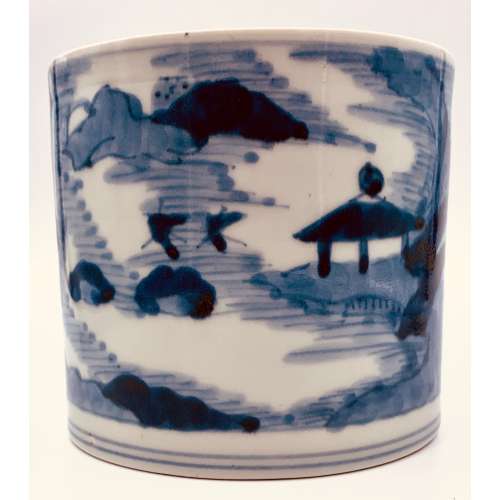
-
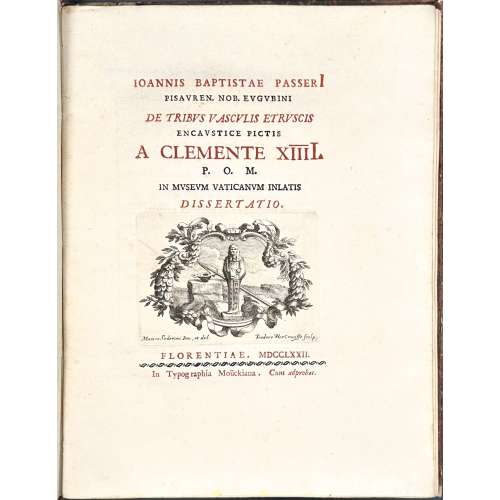 Owner’s wrappers, 28 x 21 cm, printed on laid paper, unpaginated, collated ffl, [A, B]4 C-G4, 2 ffl; total 28 leaves plus 5 engraved plates by Allegrini after Mariotti; engraved title-page (Vercruys after Soderini), head- and tailpieces (Gregori after del Moro) and initials. Owner's label to front pastedown: Marc Burdin, prêtre. Title-page (engraved, red and black): IOANNIS BAPTISTAE PASSERI | PISAUREN. NOB. EUGUBINI | DE TRIBUS VASCULIS ETRUSCIS | ENCAUSTICE PICTIS | A CLEMENTE XIIII. | P.O.M. | IN MUSEUM VATICANUM INLATIS | DISSERTATIO. | {VIGNETTE} | FLORENTIAE. MDCCLXXII. | ~ | in Typographia Moückiana. Cum adprobat. || Dedication: ANTIQVARIAE. ERVDITIONIS. PROPAGATORI EXIMIO ABSOLVTISSIMAM . HANC. DISSERTATIONEM CLARISS. PASSERII DE . IMAGINIBVS . ET . SYMBOLIS TRIVM . VASORVM . ETRVSCI . OPERIS QVAE PRINCIPIS. NOSTRI.SANCTISS. ET. SAPIENTISS. LARGITATE IN . VATICANVM . MVSEVM A. SE. CVMVLATISSIME . DITATVM INVE CTA . FVERVNT REGINALDVS.COMES.ANSIDAEVS.PATR.PERVS. M. A. CARD. PRONEPOS DEVOTVS. NOMINI . MAIESTATIQVE . EIVS DEMISSISSIME. Translation: "To the most excellent promoter of antiquities, the most accomplished: This most complete dissertation concerning the images and symbols of three Etruscan vases, which were most abundantly bestowed by our most holy and wise Prince onto the Vatican museum, was composed by the illustrious Passerius. Reginald, Count of Ansidius, true ancestral father, grandson by blood of the Cardinal, devoted most humbly and devoutly to his name and majesty." Note: P.O.M. stands for "Papa Optimo Maximo", which translates to "Father Most Excellent." For a similar vase in this collection, see VO-0098.
Owner’s wrappers, 28 x 21 cm, printed on laid paper, unpaginated, collated ffl, [A, B]4 C-G4, 2 ffl; total 28 leaves plus 5 engraved plates by Allegrini after Mariotti; engraved title-page (Vercruys after Soderini), head- and tailpieces (Gregori after del Moro) and initials. Owner's label to front pastedown: Marc Burdin, prêtre. Title-page (engraved, red and black): IOANNIS BAPTISTAE PASSERI | PISAUREN. NOB. EUGUBINI | DE TRIBUS VASCULIS ETRUSCIS | ENCAUSTICE PICTIS | A CLEMENTE XIIII. | P.O.M. | IN MUSEUM VATICANUM INLATIS | DISSERTATIO. | {VIGNETTE} | FLORENTIAE. MDCCLXXII. | ~ | in Typographia Moückiana. Cum adprobat. || Dedication: ANTIQVARIAE. ERVDITIONIS. PROPAGATORI EXIMIO ABSOLVTISSIMAM . HANC. DISSERTATIONEM CLARISS. PASSERII DE . IMAGINIBVS . ET . SYMBOLIS TRIVM . VASORVM . ETRVSCI . OPERIS QVAE PRINCIPIS. NOSTRI.SANCTISS. ET. SAPIENTISS. LARGITATE IN . VATICANVM . MVSEVM A. SE. CVMVLATISSIME . DITATVM INVE CTA . FVERVNT REGINALDVS.COMES.ANSIDAEVS.PATR.PERVS. M. A. CARD. PRONEPOS DEVOTVS. NOMINI . MAIESTATIQVE . EIVS DEMISSISSIME. Translation: "To the most excellent promoter of antiquities, the most accomplished: This most complete dissertation concerning the images and symbols of three Etruscan vases, which were most abundantly bestowed by our most holy and wise Prince onto the Vatican museum, was composed by the illustrious Passerius. Reginald, Count of Ansidius, true ancestral father, grandson by blood of the Cardinal, devoted most humbly and devoutly to his name and majesty." Note: P.O.M. stands for "Papa Optimo Maximo", which translates to "Father Most Excellent." For a similar vase in this collection, see VO-0098.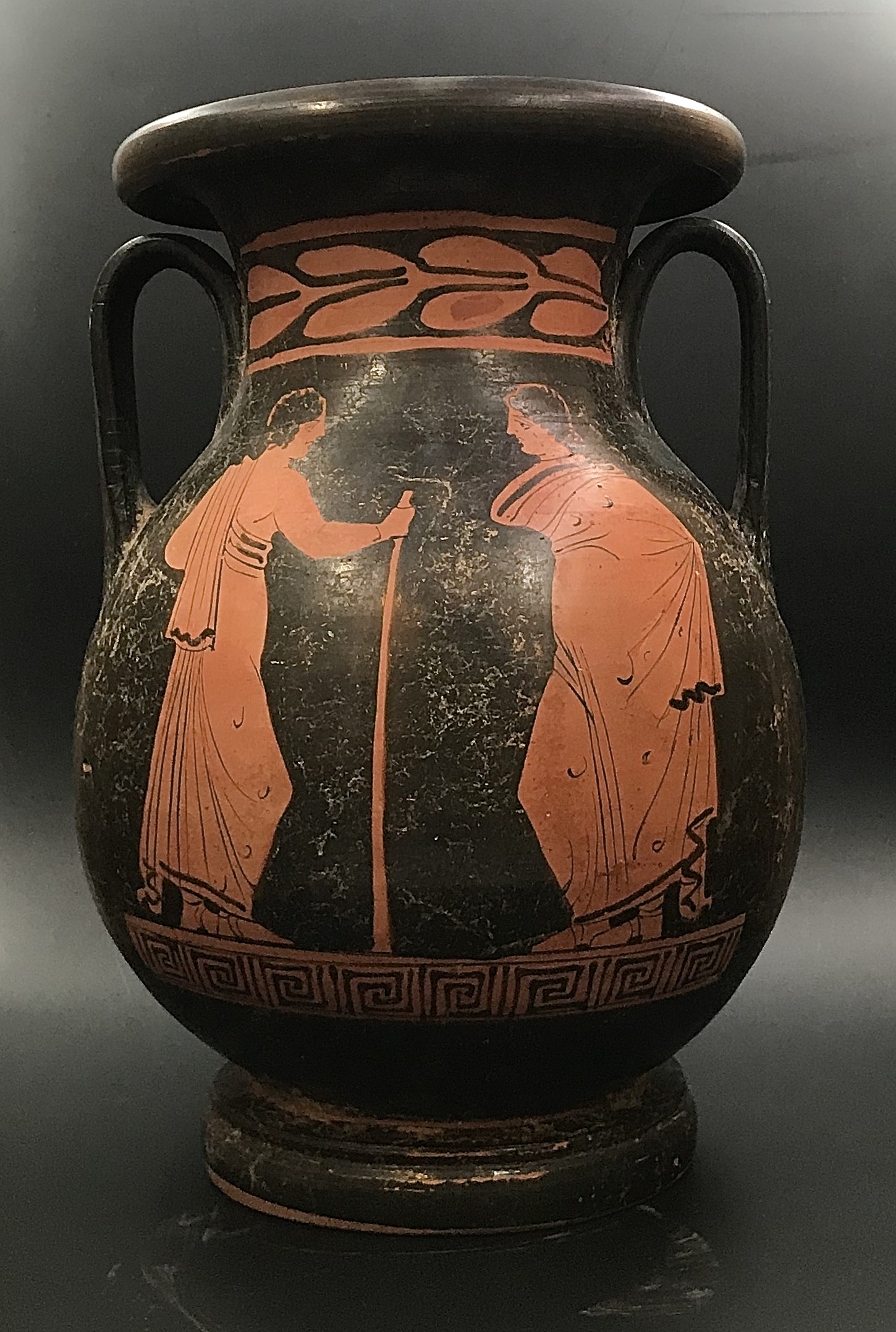
 This vase is attributed to Apulia, ca. 330 BCE. Passeri was probably wrong to attribute this type of vessel to Etruscan vase painting, produced from the 7th through the 4th centuries BC.
Contributors:
Giovanni Battista Passeri (Italian, 1694 – 1780) – author.
Francesco Moücke (Italian, fl. 1729 – 1787) – publisher.
Pope Clement XIV [Ganganelli, Giovanni Vincenzo Antonio] (Italian, 1705 – 1774) – dedicatee.
Artists:
Mauro Soderini (Italian, 1704 – after 1751)
Carlo Spiridione Mariotti (Italian, 1726 – 1790)
Lorenzo del Moro (Italian, 1677 – 1735)
Engravers:
Theodor Vercruys [Teodoro Vercruysse] (Dutch, 1678 – 1739)
Francesco Allegrini da Gubbio (Italian, 1587 – 1663)
Carlo Bartolomeo Gregori (Italian, 1702 – 1759)
This vase is attributed to Apulia, ca. 330 BCE. Passeri was probably wrong to attribute this type of vessel to Etruscan vase painting, produced from the 7th through the 4th centuries BC.
Contributors:
Giovanni Battista Passeri (Italian, 1694 – 1780) – author.
Francesco Moücke (Italian, fl. 1729 – 1787) – publisher.
Pope Clement XIV [Ganganelli, Giovanni Vincenzo Antonio] (Italian, 1705 – 1774) – dedicatee.
Artists:
Mauro Soderini (Italian, 1704 – after 1751)
Carlo Spiridione Mariotti (Italian, 1726 – 1790)
Lorenzo del Moro (Italian, 1677 – 1735)
Engravers:
Theodor Vercruys [Teodoro Vercruysse] (Dutch, 1678 – 1739)
Francesco Allegrini da Gubbio (Italian, 1587 – 1663)
Carlo Bartolomeo Gregori (Italian, 1702 – 1759) -
 Ippitsusai Bunchō [一筆斎文調] (Japanese, 1725 – 1794). Size: Vertical Hosoban. As the Library of Congress put it: "Print shows the actor Ichikawa Monnosuke II, full-length portrait, facing left, standing on the snow-covered veranda". Actor: Ichikawa Monnosuke II [市川門之助] (Japanese, 1743/56 – 1794); other names: Ichikawa Benzō I, Takinaka Hidematsu II, Takinaka Tsuruzō. According to Heroes of the Kabuki Stage [LIB-1197.2016] Ichikawa Monnosuke II was active from 11/1770 to 10/1794. Play: Chūshingura [忠臣蔵] (The Treasury of Loyal Retainers), played at Nakamuraza in the 4the month of Meiwa 8 (1771). The actor played in a variety of roles and performances and was the subject of multiple woodblock prints by many famous ukiyo-e artists, including Bunchō, Katukawa Shunkō, Katukawa Shunshō, Katsukawa Shun'ei, Tōshūsai Sharaku, and many others. Ref: Vever (1976), vol. 1, № 242, p. 227.
Ippitsusai Bunchō [一筆斎文調] (Japanese, 1725 – 1794). Size: Vertical Hosoban. As the Library of Congress put it: "Print shows the actor Ichikawa Monnosuke II, full-length portrait, facing left, standing on the snow-covered veranda". Actor: Ichikawa Monnosuke II [市川門之助] (Japanese, 1743/56 – 1794); other names: Ichikawa Benzō I, Takinaka Hidematsu II, Takinaka Tsuruzō. According to Heroes of the Kabuki Stage [LIB-1197.2016] Ichikawa Monnosuke II was active from 11/1770 to 10/1794. Play: Chūshingura [忠臣蔵] (The Treasury of Loyal Retainers), played at Nakamuraza in the 4the month of Meiwa 8 (1771). The actor played in a variety of roles and performances and was the subject of multiple woodblock prints by many famous ukiyo-e artists, including Bunchō, Katukawa Shunkō, Katukawa Shunshō, Katsukawa Shun'ei, Tōshūsai Sharaku, and many others. Ref: Vever (1976), vol. 1, № 242, p. 227.
Katsukawa Shun'ei. The Actor Ichikawa Monnosuke II in an Aragoto Role. LACME.

Actor Ichikawa Monnosuke II as Date no Yosaku Artist Tôshûsai Sharaku (Japanese, active 1794–1795), Publisher Tsutaya Jûzaburô (Kôshodô) (Japanese) 1794 (Kansei 6), 5th month. MFA.

Ippitsusai Bunchô. Actor Ichikawa Monnosuke II as Tsunewakamaru. Play: Iro Moyô Aoyagi Soga Theater: Nakamura. MFA.
-
 Ippitsusai Bunchō (一筆斎文調); lived 1725-1794; flourished 1755–1790. Size: Chuban; 26 x 20 cm The design presents a young woman reading a scroll while arranging her hear, and a young man with a rowing rod watching over her shoulder; the pair is standing on a giant shrimp that ferries them over a stream. The third passenger is a literate octopus, who's is attentively exploring the text of a scroll. This allusion comes to mind promptly: “Bodhidharma crossing the Yangzi River on a reed” (Royō Daruma).
Ippitsusai Bunchō (一筆斎文調); lived 1725-1794; flourished 1755–1790. Size: Chuban; 26 x 20 cm The design presents a young woman reading a scroll while arranging her hear, and a young man with a rowing rod watching over her shoulder; the pair is standing on a giant shrimp that ferries them over a stream. The third passenger is a literate octopus, who's is attentively exploring the text of a scroll. This allusion comes to mind promptly: “Bodhidharma crossing the Yangzi River on a reed” (Royō Daruma). Image from Asian Art Museum in San Francisco:
Image from Asian Art Museum in San Francisco:
Masanobu’s mitate wittily evokes an episode known as “Bodhidharma crossing the Yangzi River on a reed” (Royō Daruma). According to legend, the river crossing occurred en route to the Shaolin monastery, where Bodhidharma sat facing a wall for nine years without speaking. While serious interpretations abound in Chinese and Japanese paintings, popular prints of the Edo period often playfully substituted a beautiful woman for the monk. This parodic version was reportedly invented in response to a courtesan’s comment that she was more enlightened than Bodhidharma because she had spent ten years sitting, on display in a brothel.
An interesting article about this particular design is published at UKIYO-E.ORG BLOG. Though, the design is erroneously attributed to Harunobu. We see that Bunchō was quite fascinated by the idea of crossing a water obstacle with the help of an unsuitable means of transportation:
Female Daruma Riding a Mushroom. MFA # 21.4758.


